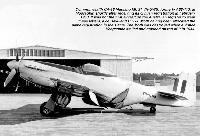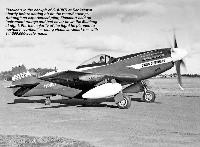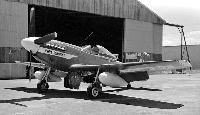Фотографии
-
Регистрационный номер: VH-BVM [2] Ten months after Whiteman’s trans-Tasman flight, VH-BVM was sold to a new owner, racing driver Arnold Glass, who painted the machine a vivid red for the 1954 REDeX Round Australia Air Trial and named it Johnny Zero. The name of one of the aircraft’s sponsors, Capitol Motor Cycles of 21 Campbell St, Sydney, was painted on the rear fuselage, the engine cowling bearing the owner’s name and the legend “Mustang Sports Special P51D”.
Самолёты на фотографии: North American P-51D Mustang - США - 1944
-
Регистрационный номер: G-ARUK [3] In April 1962 VH-UWB was sold to AREF Ltd of Ascot and put on the British civil register as G-ARUK. Flockhart’s colours for his second attempt on the Australia-UK record would again be a vibrant red, with sponsorship from Air BP and Air-lndia. The Australian phrase ‘‘She’ll be right” was painted on the lower cowling.
Самолёты на фотографии: North American P-51D Mustang - США - 1944
-
Регистрационный номер: VH-UWB [2], A68-113 [2] Sporting a striking yellow and very dark blue colour scheme, Mustang VH-UWB is seen here at Ballarat Aerodrome, north-west of Melbourne, in November 1961. In July that year, the incorrectly refitted canopy slid back during flight and left the pilot temporarily unconscious; thankfully he recovered and a safe landing was made.
Самолёты на фотографии: North American P-51D Mustang - США - 1944
-
Регистрационный номер: G-ARUK [3] Filling the Mustang’s droptanks at Alice Springs on February 28, 1961, during the first leg of Flockhart’s attempt on the Australia-UK record.
Самолёты на фотографии: North American P-51D Mustang - США - 1944
-
Регистрационный номер: G-ARUK [3] Flockhart beside G-ARUK outside the Brookes Aviation hangar at Moorabbin on the morning of his final fatal flight on April 11, 1962. The Scotsman was anxious to get to Bankstown to conduct fuel consumption tests and oversee modifications to the navigation equipment in time for his planned departure for the UK on April 16.
Самолёты на фотографии: North American P-51D Mustang - США - 1944
-
Регистрационный номер: VH-BVM [2] Mustang VH-BVM at Bankstown, Sydney, in 1960, before its purchase by United Dominions Trust in early 1961 for Flockhart’s proposed record attempt. It was the first Australian Mustang to be sold on the civil market and was used by “Wac” Whiteman to set a new speed record for the crossing of the Tasman Sea in July 1953.
Самолёты на фотографии: North American P-51D Mustang - США - 1944
-
Регистрационный номер: G-ARKD [9] Flockhart at the controls of G-ARKD during a test flight from Bankstown. The RAAF’s CA-17 Mustang Mk 20s were built from sets of parts supplied by North American Aviation (plus Packard Merlin engines) and assembled by the Commonwealth Aircraft Corporation (CAC). The first CAC-produced example, A68-1, made its first flight on April 29, 1945.
Самолёты на фотографии: North American P-51D Mustang - США - 1944
-
Регистрационный номер: G-ARKD [9] A dejected Flockhart at Athens on March 3, 1961. “Tired and rather angry, but not despondent, Ron Flockhart abandoned at Athens his valiant attempt to fly solo from Sydney to London faster than anyone in a piston-engined aeroplane had ever done before” - thus ran a news item in the March 10, 1961, issue of Flight.
Самолёты на фотографии: North American P-51D Mustang - США - 1944
-
Регистрационный номер: G-ARKD [9] Flockhart poses beside the Mustang at Bankstown during a photo-call in the days before his record attempt. As chief sponsor, United Dominions got pride of place on the engine cowling beneath the exhaust stacks, with the legend ‘‘Rolls-Royce Mustang XX” above (despite the engine being an American-built Packard Merlin 38).
Самолёты на фотографии: North American P-51D Mustang - США - 1944
-
Регистрационный номер: G-ARKD [9] Flockhart poses under the wheelwell of Mustang G-ARKD in 1961.
Самолёты на фотографии: North American P-51D Mustang - США - 1944
-
Регистрационный номер: G-ARKD [9] When asked what it was like flying a high-performance piston-engined fighter on a route almost exclusively reserved for large airliners and transport aircraft, Flockhart replied that it was “like driving a Cooper [racing car] on a bus route..."
Самолёты на фотографии: North American P-51D Mustang - США - 1944
-
Регистрационный номер: G-ARKD [9] Bearing the legend ‘‘Sydney-London” on the rear fuselage, the Mustang is taxied out of the Fawcett hangar by Flockhart. The two white 75 US gal combat droptanks brought the total fuel capacity of the Mustang to 420 US gal (350 Imp gal) when added to the tanks in the fuselage (85 US gal) and wings (92 1/2 US gal each).
Самолёты на фотографии: North American P-51D Mustang - США - 1944
-
Регистрационный номер: VH-UWB [2], A68-113 [2] Commonwealth CA-18 Mustang Mk 21 VH-UWB, formerly A68-113, at Moorabbin shortly after receiving its civilian registration in February 1958. It was not the first aircraft on the Australian register to wear these letters, a de Havilland D.H.60 Moth having been allocated the same registration in the 1930s. The Moth was destroyed when a Vultee Vengeance stalled and crashed on top of it in 1944.
Самолёты на фотографии: North American P-51D Mustang - США - 1944
-
Регистрационный номер: G-ARKD [9] Flockhart in the cockpit of G-ARKD at Bankstown shortly before setting off on the record attempt. Although an experienced pilot, Flockhart held no instrument ratings and had never flown the Mustang at night. For the majority of the flight he planned to navigate "contact” - using visual landmarks - with 1:1,000,000-scale maps.
Самолёты на фотографии: North American P-51D Mustang - США - 1944
-
Регистрационный номер: G-ARKD [9] Looking factory-fresh in its new United Dominions Trust red and white colour scheme, G-ARKD sits in the sunshine outside the Fawcett Aviation hangar at Bankstown. The Mustang was put on the British register on February 18, 1961, test flown two days later and issued its British Certificate of Airworthiness on February 24.
Самолёты на фотографии: North American P-51D Mustang - США - 1944
-
Регистрационный номер: G-ARKD [9] The Mustang at Athens after the cockpit fire - note the melted canopy - on September 7, 1961. The aircraft was struck off the British register that November, but continued to languish at Athens airport throughout the 1960s. Its remains appear to have been imported back to the UK in 2012, presumably for a future restoration.
Самолёты на фотографии: North American P-51D Mustang - США - 1944
Статьи
- -
- B.Gardner - Foxable Four
- G.Ellis - Brothers in Arms
- J.Franzi - Smile Please...! /An eye for detail/
- J.Stroud - The Finnish Line /The John Stroud Archive/
- M.Nelson - A Model Prisoner
- M.Willis, D.Armson - "A snowflake settling on the water..."
- N.Follett - Ron Flockhart's Pony Express
- N.Stroud - The Magnificient 7
- P.Davidson - Off the Beaten Track...
- P.Jarrett - Lost & Found
- P.Jarrett - Mr. Cody & Mr. Roe (2)
- R.White - The New Frontier
- S.Aloni - The Pick-up Artist
- T.Jones - Air International Affair















